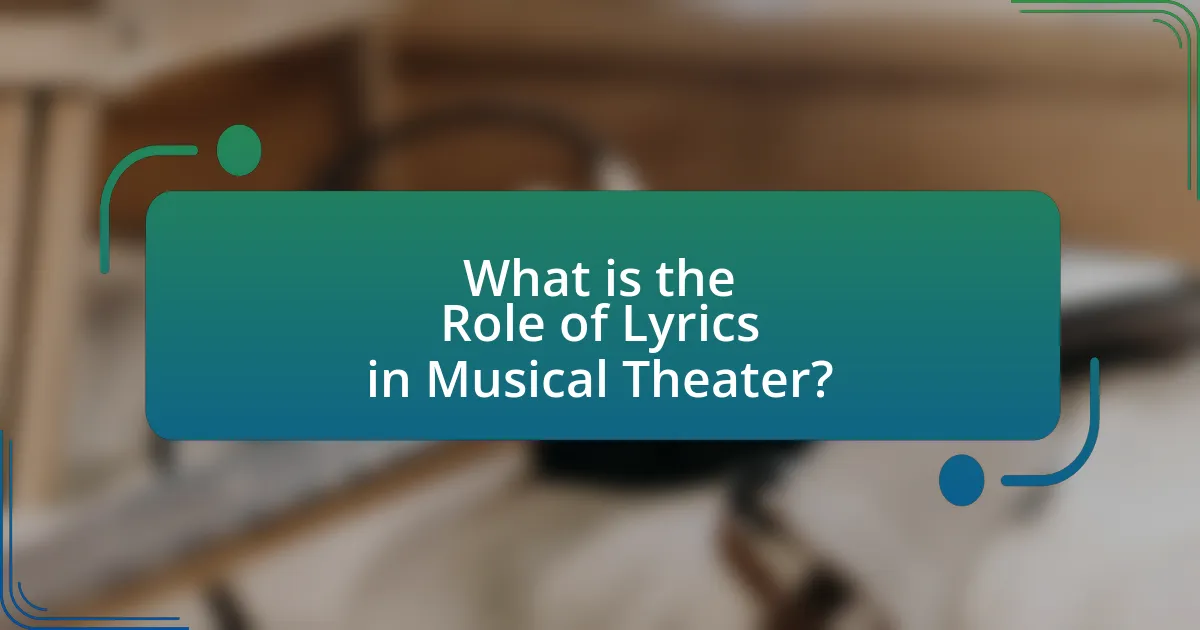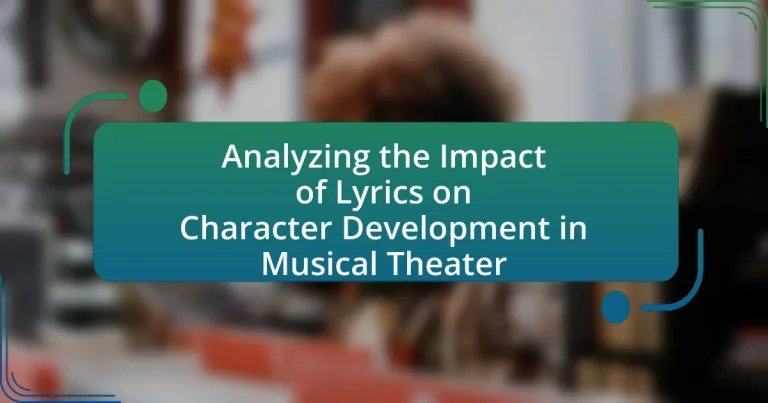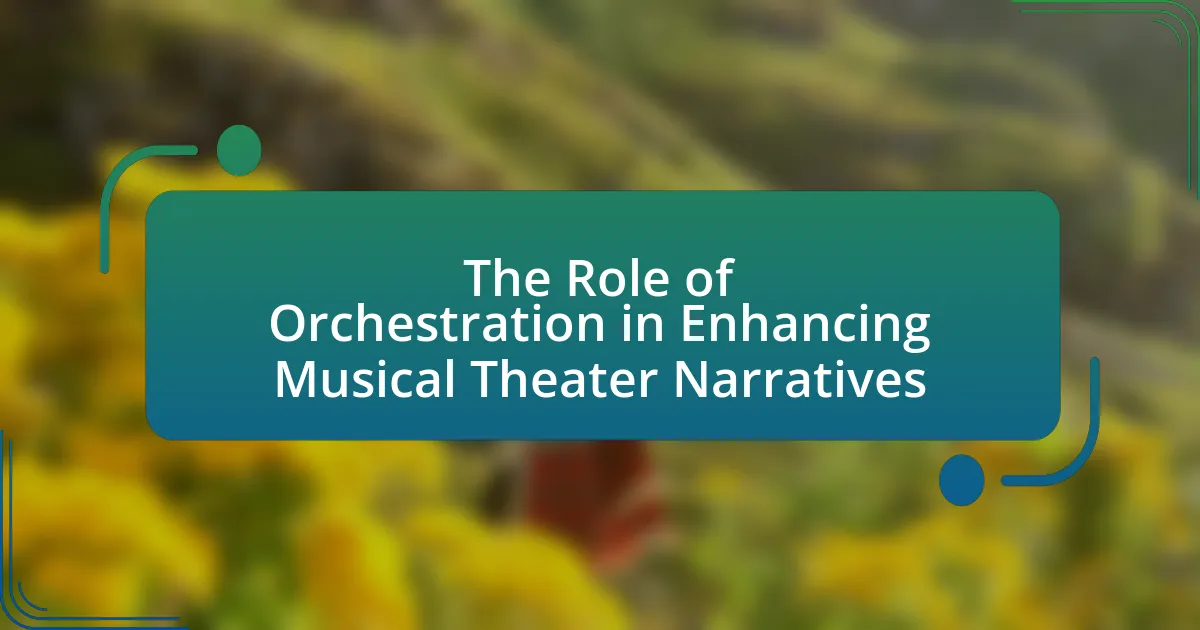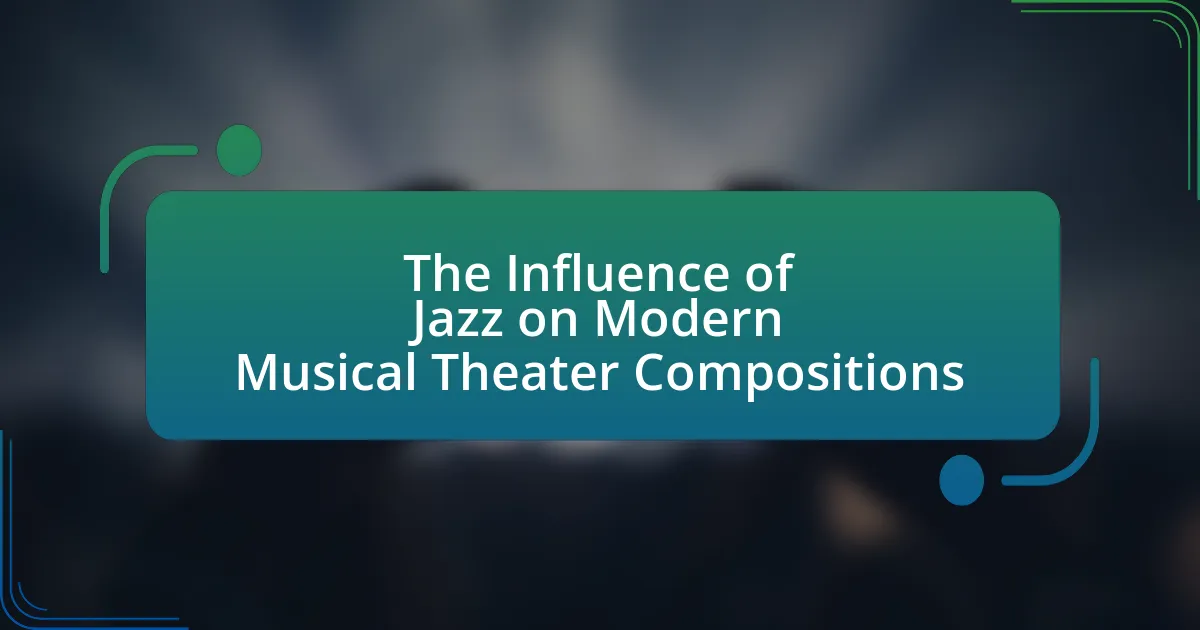The article analyzes the impact of lyrics on character development in musical theater, emphasizing their role as a narrative device that conveys emotions, advances plots, and enhances themes. It explores how lyrics provide insight into characters’ thoughts and feelings, facilitating audience engagement and empathy. Key elements discussed include the emotional depth of lyrics, their contribution to storytelling, and the techniques composers use to align lyrics with character traits. Additionally, the article examines historical perspectives on lyrics, their influence across different musical genres, and best practices for writing impactful lyrics that effectively convey character emotions.

What is the Role of Lyrics in Musical Theater?
Lyrics in musical theater serve as a crucial narrative device that conveys character emotions, advances the plot, and enhances thematic elements. They provide insight into a character’s thoughts and feelings, allowing the audience to connect with their journey. For instance, in “Hamilton,” Lin-Manuel Miranda uses lyrics to express the internal struggles and motivations of historical figures, thereby deepening character development and engagement. This integration of lyrics into storytelling is essential, as it transforms dialogue into a musical experience that resonates with audiences, making the characters’ arcs more relatable and impactful.
How do lyrics contribute to storytelling in musicals?
Lyrics contribute to storytelling in musicals by conveying characters’ emotions, motivations, and conflicts directly to the audience. Through the use of lyrical content, characters can express their inner thoughts and feelings, which enhances the narrative and allows for deeper audience engagement. For example, in “Les Misérables,” the song “I Dreamed a Dream” reveals Fantine’s despair and longing, effectively advancing her character arc and the overall plot. This direct expression of character emotions through lyrics serves as a crucial tool for storytelling, making the narrative more relatable and impactful for the audience.
What elements of lyrics enhance character arcs?
Elements of lyrics that enhance character arcs include emotional depth, narrative progression, and thematic resonance. Emotional depth allows characters to express their inner thoughts and feelings, creating a connection with the audience. For example, in “Les Misérables,” Jean Valjean’s soliloquy reveals his struggles and transformation, illustrating his character development. Narrative progression in lyrics helps to advance the storyline, as seen in “Hamilton,” where characters’ motivations and conflicts are articulated through songs, driving the plot forward. Thematic resonance ties the character’s journey to broader themes, such as love, redemption, or social justice, which can be observed in “Rent,” where the characters’ experiences reflect societal issues, enhancing their arcs. These elements collectively contribute to a richer understanding of character development in musical theater.
How do lyrics reflect the emotional states of characters?
Lyrics reflect the emotional states of characters by articulating their feelings, thoughts, and experiences in a way that resonates with the audience. In musical theater, lyrics serve as a direct expression of a character’s internal struggles, desires, and transformations, often revealing their motivations and conflicts. For example, in “Les Misérables,” the song “I Dreamed a Dream” conveys Fantine’s despair and loss, encapsulating her emotional turmoil through poignant language and imagery. This connection between lyrics and emotion enhances character development, allowing the audience to empathize with their journeys and understand their complexities.
Why are lyrics considered a vital component of character development?
Lyrics are considered a vital component of character development because they provide insight into a character’s thoughts, emotions, and motivations. In musical theater, lyrics often serve as a direct expression of a character’s inner struggles and desires, allowing the audience to connect with them on a deeper level. For example, in “Hamilton,” the lyrics reveal Alexander Hamilton’s ambition and personal conflicts, which are crucial for understanding his character arc. This integration of lyrics into storytelling enhances character depth and facilitates emotional engagement, making them essential for effective character development.
What are the historical perspectives on lyrics in character portrayal?
Historical perspectives on lyrics in character portrayal reveal that lyrics have been integral to character development since the inception of musical theater. In the 18th century, operas utilized lyrics to express characters’ emotions and motivations, establishing a foundation for narrative-driven songs. By the 19th century, the emergence of the musical comedy genre further emphasized the role of lyrics in character portrayal, as seen in works like “The Black Crook,” where songs advanced the plot and deepened character relationships. The 20th century introduced more complex characters in musicals such as “West Side Story,” where lyrics conveyed inner conflicts and societal issues, enhancing character depth. This evolution illustrates that lyrics have consistently served as a vital tool for character exploration and audience engagement throughout the history of musical theater.
How do different musical genres influence lyrical content?
Different musical genres significantly influence lyrical content by shaping themes, language, and emotional expression. For instance, hip-hop often features storytelling and social commentary, reflecting personal and cultural experiences, while country music typically emphasizes narrative-driven lyrics about love, loss, and rural life. Rock music frequently explores themes of rebellion and existential angst, using metaphorical language to convey deeper meanings. These genre-specific characteristics are supported by studies, such as those by the Journal of Popular Music Studies, which highlight how lyrical themes align with cultural contexts and audience expectations. Thus, the genre of music directly impacts the style and substance of its lyrics, influencing how characters and narratives are developed in musical theater.

How do Lyrics Shape Character Identity?
Lyrics shape character identity by providing insight into a character’s emotions, motivations, and personal experiences. In musical theater, lyrics often serve as a direct expression of a character’s inner thoughts, allowing the audience to understand their struggles and aspirations. For example, in “Hamilton,” the lyrics of “My Shot” reveal Alexander Hamilton’s ambition and determination, which are central to his identity. This connection between lyrics and character identity is supported by research indicating that musical elements, including lyrics, significantly influence audience perception and emotional engagement with characters (Hanna, 2018, “The Role of Music in Character Development,” Journal of Musical Theater Studies).
What techniques do composers use to align lyrics with character traits?
Composers use techniques such as character-specific language, emotional tone, and rhythmic patterns to align lyrics with character traits. Character-specific language involves choosing words and phrases that reflect a character’s personality, background, and motivations, enhancing audience understanding of the character. Emotional tone is conveyed through the choice of melody and harmony, which can evoke feelings that resonate with the character’s emotional state. Rhythmic patterns can also mirror a character’s traits; for example, a character who is anxious may have lyrics set to a quick, staccato rhythm, while a more relaxed character may have flowing, legato phrases. These techniques collectively ensure that the lyrics not only tell a story but also deepen the audience’s connection to the characters.
How do metaphors and imagery in lyrics define characters?
Metaphors and imagery in lyrics define characters by providing deeper insights into their emotions, motivations, and relationships. For instance, when a character is described using metaphors related to nature, such as “a storm brewing inside,” it conveys internal conflict and turmoil, allowing the audience to understand their struggles. Imagery, such as “dancing in the moonlight,” can illustrate a character’s longing for freedom or joy, enhancing the audience’s connection to their experiences. This use of figurative language enriches character development by creating vivid mental pictures that evoke empathy and understanding, ultimately shaping how the audience perceives and relates to the characters in the narrative.
What role does repetition play in establishing character identity?
Repetition plays a crucial role in establishing character identity by reinforcing key traits and emotions associated with a character. In musical theater, repeated phrases or motifs in lyrics can highlight a character’s motivations, fears, or desires, making them more memorable to the audience. For instance, in “Les Misérables,” the character of Jean Valjean frequently repeats the phrase “Who am I?” which emphasizes his internal struggle with identity and redemption. This technique not only deepens the audience’s understanding of the character but also creates a strong emotional connection, as the repetition serves to underscore the character’s journey and transformation throughout the narrative.
How do lyrics evolve alongside character development?
Lyrics evolve alongside character development by reflecting the emotional and psychological changes that characters undergo throughout a narrative. As characters face challenges, their motivations and perspectives shift, which is often mirrored in the lyrics they sing. For example, in the musical “Hamilton,” Alexander Hamilton’s journey from ambition to regret is encapsulated in the evolving lyrics of his songs, illustrating his internal conflicts and growth. This alignment between lyrics and character arcs enhances storytelling by providing insight into characters’ thoughts and feelings, thereby deepening audience engagement and understanding of the narrative.
What are examples of character transformation reflected in lyrics?
Examples of character transformation reflected in lyrics include the evolution of Elphaba in “Wicked,” where her journey from misunderstood girl to powerful witch is captured in the song “Defying Gravity.” This transformation illustrates her rejection of societal norms and acceptance of her true self. Another example is Jean Valjean in “Les Misérables,” whose redemption arc is highlighted in “Who Am I?” as he grapples with his past and seeks to become a better person. These lyrics effectively convey the internal struggles and growth of the characters, showcasing their development through music.
How do lyrics signal changes in a character’s journey?
Lyrics signal changes in a character’s journey by reflecting their emotional state and development throughout the narrative. As characters face challenges and evolve, the lyrics often shift in tone, vocabulary, and perspective, illustrating their internal conflicts and resolutions. For example, in “Les Misérables,” the character Jean Valjean’s transformation is marked by the lyrics of “Who Am I?” which convey his struggle with identity and redemption. This change in lyrical content effectively communicates his growth from a hardened ex-convict to a compassionate individual, demonstrating how lyrics serve as a narrative device to highlight character evolution in musical theater.

What are the Impacts of Lyrics on Audience Perception?
Lyrics significantly influence audience perception by shaping emotional responses and guiding interpretations of characters and narratives. The language, themes, and imagery within lyrics can evoke specific feelings, create connections to characters, and enhance the overall storytelling experience. For instance, research by the University of Southern California found that emotionally charged lyrics can lead to stronger audience engagement and empathy towards characters, as they resonate with personal experiences and emotions. This connection is crucial in musical theater, where lyrics serve as a primary vehicle for character development and plot progression, ultimately affecting how audiences perceive and relate to the story being told.
How do lyrics influence audience empathy towards characters?
Lyrics significantly influence audience empathy towards characters by conveying emotions, motivations, and personal struggles. Through the use of vivid imagery and relatable themes, lyrics allow audiences to connect with characters on a deeper emotional level. For instance, in the musical “Les Misérables,” the song “I Dreamed a Dream” expresses Fantine’s despair and longing, evoking sympathy from the audience as they witness her tragic circumstances. This emotional resonance is further supported by research indicating that music and lyrics can activate brain regions associated with empathy, enhancing the audience’s ability to understand and feel for the characters’ experiences.
What psychological effects do lyrics have on audience engagement?
Lyrics significantly influence audience engagement by evoking emotions and fostering connections to the narrative. When lyrics resonate with listeners, they can trigger psychological responses such as empathy, nostalgia, or excitement, enhancing the overall experience of the musical. Research indicates that emotionally charged lyrics can activate brain regions associated with reward and emotional processing, leading to increased engagement and retention of the story. For instance, a study published in the journal “Psychology of Music” by Hargreaves and North (1999) found that lyrics that convey strong emotional content lead to greater audience involvement and memory recall. This demonstrates that the psychological effects of lyrics are crucial in shaping how audiences connect with characters and the overarching themes in musical theater.
How do lyrics create a connection between the audience and characters?
Lyrics create a connection between the audience and characters by conveying emotions, thoughts, and narratives that resonate with the listeners. Through the use of relatable themes and personal experiences, lyrics allow audiences to empathize with characters’ struggles and triumphs. For example, in the musical “Hamilton,” Lin-Manuel Miranda uses lyrics to express the internal conflicts and aspirations of historical figures, making them accessible and relatable to modern audiences. This emotional engagement is supported by research indicating that music and lyrics can evoke strong emotional responses, enhancing the audience’s connection to the characters and their journeys.
What are the best practices for writing impactful lyrics for character development?
The best practices for writing impactful lyrics for character development include creating a strong emotional connection, using vivid imagery, and ensuring character consistency. Strong emotional connections can be established by reflecting the character’s inner thoughts and feelings, which allows the audience to empathize with them. Vivid imagery enhances the storytelling aspect of the lyrics, making the character’s experiences more relatable and memorable. Additionally, maintaining character consistency throughout the lyrics ensures that the character’s voice and motivations remain clear, which is crucial for audience engagement. These practices are supported by successful musical theater examples, such as “Hamilton,” where Lin-Manuel Miranda uses personal narratives and historical context to deepen character development through lyrics.
How can lyricists effectively convey character emotions through words?
Lyricists can effectively convey character emotions through words by utilizing vivid imagery, specific language, and emotional resonance. Vivid imagery allows listeners to visualize the character’s feelings, while specific language helps to articulate those emotions clearly. Emotional resonance is achieved by tapping into universal feelings that audiences can relate to, making the character’s experience more impactful. For example, in the musical “Hamilton,” Lin-Manuel Miranda uses precise language and historical context to express the characters’ struggles and aspirations, which enhances the emotional depth of the narrative. This approach not only engages the audience but also deepens their understanding of character development within the musical.
What common pitfalls should be avoided in character-driven lyrics?
Common pitfalls to avoid in character-driven lyrics include clichés, lack of specificity, and inconsistent character voice. Clichés dilute the emotional impact and originality of the lyrics, making them less relatable and memorable. Lack of specificity can lead to vague storytelling, preventing the audience from fully engaging with the character’s journey. Inconsistent character voice disrupts the narrative flow and confuses the audience about the character’s identity and motivations. These pitfalls hinder effective character development and diminish the overall impact of the musical.




